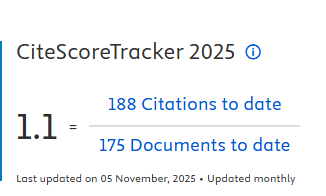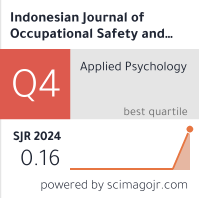Biomonitoring of Nicotine Exposure in Tobacco Farmers with Green Tobacco Sickness Symptoms

Downloads
Introduction: Indonesia is the fifth tobacco producing country in the world. The climate and weather in Indonesia are very suitable for tobacco plantations. At harvest season, tobacco farmers face the risk of being exposed to nicotine compounds due to skin contact with tobacco leaves. This exposure can cause a syndrome known as Green Tobacco Sickness (GTS) with symptoms of nausea, vomiting, weakness, dizziness, headache, insomnia and loss of appetite. These symptoms are not specific enough to describe GTS, so biological monitoring is required. As one of the main metabolites, cotinine has been used as a biological marker to assess nicotine exposure. This study aims to examine the reliability of nicotine biomonitoring in tobacco farmers with symptoms of GTS. Methods: We searched the online electronic databases, namely PubMed, Cochrane, and Scopus for appropriate evidence based material. We then made adjustments using the inclusion and exclusion critertia to then conduct a critical review of the selected articles. Results: We obtained four articles, consisting of 3 articles examining urinary cotinine as a biomarker of nicotine exposure, and another 1 article examining cotinine saliva. The articles gave us the similar pattern that in tobacco farmers with GTS symptoms there was an increase in cotinine levels, both measured in urine and saliva. Conclusion: Based on the articles obtained, cotinine, as a nicotine metabolite, can be a reliable biomarker assessing nicotine exposure in tobacco farmers with GTS symptoms. However, more research is needed to compare the best selection of biological samples such as urine, blood or saliva.
lkam, T. and Nabeshima, T. (2019) ‘Molecular Mechanisms for Nicotine Intoxication', Neurochemistry International, 125(February), pp. 117–126.
Alves, J. et al. (2020) ‘Impact of Nicotine-Induced Green Tobacco Sickness on DNA Damage and the Relation with Symptoms and Alterations of Redox Status in Tobacco Farmers', Ecotoxicology and Environmental Safety, 206(September), pp. 1–7.
Asha, V. and Dhanya M. (2015) ‘Immunochromatographic Assessment of Salivary Cotinine and Its Correlation With Nicotine Dependence in Tobacco Chewers', Journal of Cancer Prevention, 20(2), pp. 159–163.
Balhara, Y. P. S. and Sarkar, S. (2016) Neuropathology of Drug Addictions and Substance Misuse. London: King Collage's London.
Benowitz, N. L. et al. (2016) ‘Disposition Kinetics and Metabolism of Nicotine and Cotinine in African American Smokers: Impact of CYP2A6 Genetic Variation and Enzymatic Activity', Pharmacogenet Genomics, 26(7), pp. 340–350.
Bonamonte, D. et al. (2016) ‘Tobacco-Induced Contact Dermatitis', European Journal of Dermatology, 26(3), pp. 223–231.
Boogaard, P. J., Hays, S. M. and Aylward, L. L. (2011) ‘Human Biomonitoring as A Pragmatic Tool to Support Health Risk Management of Chemicals – Examples under the EU REACH Programme', Regulatory Toxicology and Pharmacology, 59(1), pp. 125–132.
Campos, í‰. et al. (2020) ‘Occurrence of Green Tobacco Sickness and Associated Factors in Farmers Residing in Dom Feliciano Municipality, Rio Grande do Sul State, Southern Region of Brazil', Cadernos de Saude Publica, 36(8), pp. 1–15.
Ganzleben, C, et al. (2017) ‘Human Biomonitoring as A Tool to Support Chemicals Regulation in the European Union', International Journal of Hygiene and Environmental Health, 220(2), pp. 94–97.
Cezar-Vaz, M. R. and Cargnin, M. C. D. S. (2019) ‘Use of Cotinine Biomarker in Workers to Detect Green Tobacco Sickness', Revista Latino-Americana de Enfermagem, 27.
Direktorat Jenderal Perkebunan, K. P. R. I. (2019) Statistik Perkebunan Indonesia Komoditas Tembakau Tahun 2018-2020. Edited by M. Dhani Gartina, S.Kom, et al. Jakarta: Sekretariat Direktorat Jenderal Perkebunan, Direktorat Jenderal Perkebunan. Kementerian Pertanian.
Djajadi, D. (2015) ‘Tobacco Diversity in Indonesia',Journal of Biological Researches, 20(2), pp. 27–32.
Everatt, R. et al. (2013) ‘Biomonitoring Study of Dry Cleaning Workers using Cytogenetic Tests and the Comet Assay', Journal of Occupational and Environmental Hygiene, 10(11), pp. 609–621.
Fotedar, S. and Fotedar, V. (2017) ‘Green Tobacco Sickness: A Brief Review', Indian Journal of Occupational and Environmental Medicine, 21(3), pp. 101–104.
Haines, D. A. et al. (2019) ‘An Overview of Human Biomonitoring of Environmental Chemicals in the Canadian Health Measures Survey: 2007 – 2019', International Journal of Hygiene and Environmental Health, 220(2), pp. 13–28.
Loukola, A. et al. (2015) ‘Genome-Wide Association Study of a Biomarker of Nicotine Metabolism', PLoS Genet, 11(9), pp. 1–23.
Mishra, A. et al. (2015) ‘Harmful Effects of Nicotine', Indian Journal of Medical and Paediatric Oncology, 36(1), pp. 24–31.
Da Mota E Silva, M. S. et al. (2018) ‘Green Tobacco Sickness among Brazilian Farm Workers and Genetic Polymorphisms', BMC Research Notes, 11(1), pp. 1–5.
Murphy, S. E. (2017) ‘Nicotine Metabolism and Smoking: Ethnic Differences in the Role of P450 2A6', Chemical Research in Toxicology, 30(1), pp. 410–419.
NCBI (2021) PubChem Compound Summary for CID 89594, Nicotine.
Park, S. J. et al. (2018) ‘Green Tobacco Sickness Among Tobacco Harvesters in a Korean Village', Safety and Health at Work, 9(1), pp. 71–74.
Raja, M. (2016) ‘Diagnostic Methods for Detection of Cotinine Level in Tobacco Users: A Review', Journal of Clinical and Diagnostic Research, 10(3), pp. 4–6.
Saleeon, T. et al. (2016) ‘Salivary Cotinine Levels as A Biomarker for Green Tobacco Sickness in Dry Tobacco Production among Thai Traditional Tobacco Farmers', Roczniki PaÅ„stwowego ZakÅ‚adu Higieny, 67(2), pp. 121–130.
Wardhono, A., Arifandi, J. A. and Indrawati, Y. (2019) ‘The Quality Development of Besuki Na-Oogst Tobacco in Jember Regency', Jejak, 12(1), pp. 190–203.
Copyright (c) 2022 The Indonesian Journal Of Occupational Safety and Health

This work is licensed under a Creative Commons Attribution-NonCommercial-ShareAlike 4.0 International License.

In order to be accepted and published by The Indonesian Journal of Occupational Safety and Health, Author(s) who submit an article should complete all the review process. The copyright of received articles assigned to the The Indonesian Journal of Occupational Safety and Health and Department of Safety and Health, Universitas Airlangga as publishers of the journal. The intended copyright includes the rights to publish articles in various forms (including reprints).
The Editorial Team of The Indonesian Journal Of Occupational Safety and Health and Department of Safety and Health strive to ensure that no errors occur in the articles that have been published, both data errors and statements in the article.
Users of this website will be licensed to use materials from this website following the Creative Commons Attribution-NonCommercial-ShareAlike 4.0 International License. No fees charged. Please use the materials accordingly.
------------------------------------------------------------------------------------------------------------------------------------------------------------------------------------------
Attribution ” You must give appropriate credit, provide a link to the license, and indicate if changes were made. You may do so in any reasonable manner, but not in any way that suggests the licensor endorses you or your use.
NonCommercial ” You may not use the material for commercial purposes.
ShareAlike ” If you remix, transform, or build upon the material, you must distribute your contributions under the same license as the original.







 How to Submit Articles in OJS
How to Submit Articles in OJS

























